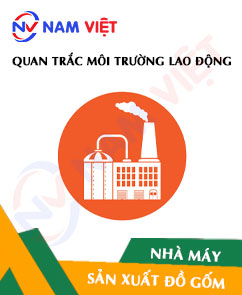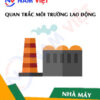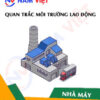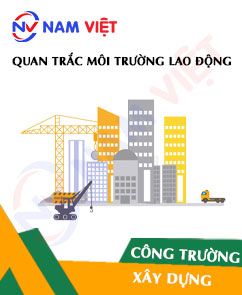Occupational environment monitoring of a ceramic manufacturing factory
99,000 ₫
Note: The above price is calculated for one sample, and the price may fluctuate depending on the area of the environment to be monitored and market movements. For more accurate pricing support, please refer to the price list or contact our consulting staff directly.
Monitoring the environment of a ceramic manufacturing factory is a session of collecting, analyzing, and evaluating factors at the workplace that may harm workers health.
Table of Contents
Toggle1. Overview of the Ceramic Manufacturing Factory
a. What is a Ceramic Manufacturing Factory?
Factory manufacturing ceramics is a place where ceramic products are made using materials such as clay, kaolin, plaster, feldspar, and other minerals. Ceramic products can include kitchenware such as bowls, plates, cups, mugs, decorative items like plant pots, interior decorations, or construction materials such as tiles, roofing tiles, and ceramic flooring.
The ceramic manufacturing process involves many stages, from raw material extraction, clay mixing, shaping, drying, to firing the products. The production technology may vary depending on the type of product and the factory’s manufacturing process.

b. Production stages in a ceramic manufacturing factory
The production stages in a ceramic manufacturing factory usually include:
- Raw material extraction: Clay is the main raw material for ceramic manufacturing. Clay is extracted from clay mines or imported from suppliers.
- Clay mixing: Clay is mixed with water and other minerals to create a clay mixture.
- Shaping: The clay mixture is shaped using tools such as a potter’s wheel, hand tools, or molds to create ceramic products according to the desired design.
- Drying: After shaping, the products are dried in a dry environment to remove moisture and prepare for firing.
- Firing: The firing process is the most important step in ceramic manufacturing. Products are placed in a kiln and fired at high temperatures for a specified time to transform the clay into hard ceramics.
- Painting or decorating: After firing, products can be painted or decorated using various techniques depending on their intended use.
- Quality control: Finally, products are checked for quality before packaging and delivery to customers.

c. Machinery used in a ceramic manufacturing factory
Common machinery in a ceramic manufacturing factory includes:
- Clay mixer: This machine is used to mix clay with water and other minerals to create a clay mixture.
- Potter’s wheel: The potter’s wheel is an essential device in shaping ceramic products. The worker can use hands or feet to spin the wheel and create ceramic products as desired.
- Drying kiln: After shaping, products are placed in a drying kiln to remove moisture and prepare for firing.
- Firing kiln: The firing process is the most crucial step in ceramic manufacturing. Kilns can be powered by electricity, coal, or gas and are controlled by computers to ensure quality and accuracy.
- Printing machine: Ceramic products can also be printed or embossed with patterns, images, or letters.
- Wood cutting machine: Sometimes ceramics need to be cut, shaped, or processed using a wood cutting machine to create special products.
- Waste treatment machine: During production, a large amount of waste is generated. Therefore, a waste treatment machine is essential to process waste and minimize environmental impact.

d. Occupational diseases that may occur for workers in a ceramic manufacturing factory
Occupational diseases that may occur for workers in a ceramic manufacturing factory include:
- Back pain and cervical spine degeneration: Due to prolonged standing or sitting in fixed positions with high frequency, workers may suffer from back pain or cervical spine degeneration.
- Respiratory diseases: Workers may be exposed to dust and toxic fumes during ceramic manufacturing, causing respiratory issues such as asthma, pneumonia, and other diseases.
- Skin diseases: Direct contact with chemicals and dust can cause burns, rashes, dermatitis, and other skin problems.
- Hearing problems: Noise in the production process may lead to hearing loss or deafness.
- Nervous system issues: Working in noisy environments and exposure to ultraviolet rays from the kiln can cause insomnia, dizziness, headaches, and other neurological issues.
- Hand disorders: Handling tools and machinery during production may cause injuries or hand disorders such as wrist or hand joint degeneration.
- Spinal disorders: Frequent work in bent or twisted positions can lead to spinal disorders such as vertebral degeneration.
- Psychological issues: Work pressure and environment can cause stress, anxiety, depression, and other psychological problems.

e. Common ceramic products on the market
Common ceramic products on the market include:
- Dishes: Including tableware and decorative plates, usually made from white porcelain or with patterns.
- Vases: Popular decorative items in various shapes, colors, and sizes.
- Tea sets: Popular in Asian tea culture, available in various styles and colors.
- Interior decorations: Including decorative items such as statues, clocks, wall hangings, and table decorations.
- Statues: Products vary in size and theme, from Buddha statues to animal statues.
- Furniture: Including sofas, dining tables, coffee tables, and other furniture items.
- Porcelain utensils: Household items such as cups, bowls, teapots, plates, and water jugs.
- Garden decorations: Including vases, animal statues, plant pots, and other garden ornaments.

2. Overview of Workplace Environmental Monitoring Services
a. What is workplace environmental monitoring at a ceramic manufacturing factory?
Workplace environmental monitoring (or occupational environment measurement) at a ceramic manufacturing factory involves collecting, evaluating, and analyzing measured indicators of workplace environmental factors in the factory. The goal is to implement timely measures to minimize environmental harm to workers’ health and prevent occupational diseases. Workplace environmental monitoring is a mandatory requirement for ceramic manufacturing factories.
Workplace environmental monitoring plays a crucial role in caring for, protecting, and enhancing workers’ health, as labor is the primary resource of a company and directly generates profits. Workers regularly exposed to risk factors or occupational hazards exceeding permissible limits may suffer health consequences and occupational diseases.
REGISTER FOR WORKPLACE ENVIRONMENTAL MONITORING SERVICE
b. Nam Viet’s workplace environmental monitoring program
Nam Viet’s workplace environmental monitoring program is designed by monitoring engineers in occupational safety and environmental protection. To ensure worker health and safety, the program uses modern measurement methods to monitor air quality, water, and factors such as microclimate, physical parameters, and dust in the work environment. This program is vital for ensuring a safe working environment and protecting workers’ health.
Additionally, Nam Viet’s program plays a key role in researching and developing new solutions to improve workplace environmental quality. With the dedication and professionalism of monitoring experts, Nam Viet’s exclusive monitoring program has become a breakthrough in occupational safety management and environmental protection in Vietnam.

c. Standardization in workplace measurement procedures
Standardization in Nam Viet’s workplace measurement procedures is essential for ensuring the accuracy of measurement results. To guarantee reliability, the program follows recognized standards and procedures issued by the Ho Chi Minh City Department of Health. This ensures that collected data can be used reliably in evaluating the work environment and making decisions to improve it for workers’ health protection.
These standardized procedures also ensure that measurements are performed by highly qualified monitoring experts with years of experience, allowing managers and specialists to trust An Toan Nam Viet’s results and make accurate, valuable decisions in protecting workers’ health and the environment.
By applying standardization in workplace measurement, Nam Viet demonstrates its commitment to ensuring a safe work environment, protecting worker health, and contributing to the development and improvement of occupational safety and environmental management in Vietnam.
d. Report on environmental monitoring results at ceramic manufacturing factories
Workplace environmental monitoring results are prepared according to Form No. 04, Appendix III issued with Decree 44/2016/ND-CP and prepared in two copies: one sent to the workplace that signed the monitoring contract, and one kept at the organization performing the environmental monitoring.
The retention period for workplace environmental monitoring results follows legal regulations, with records stored indefinitely.

e. Frequency of workplace environmental monitoring according to the law
According to Clause 2 of Article 18 of the Law on Occupational Safety and Health 84/2015/QH13, employers must organize workplace environmental monitoring to assess harmful factors at least once a year.
f. Deadline for submitting workplace environmental monitoring reports according to the law
The deadline for submission is before December 31 each year. Enterprises operating in mandatory production facilities must submit workplace environmental monitoring reports to the Department of Health at the local jurisdiction where the production facility’s headquarters are located and where workers are employed.
When there are changes in technology, production processes, or during renovation or upgrades that may introduce new harmful factors to workers’ health, enterprises must update occupational hygiene records related to the harmful factors requiring workplace environmental monitoring.
g. Penalties for violations of workplace environmental monitoring by employers
According to Article 27 of Decree No. 12/2022/ND-CP dated January 17, 2022, on administrative penalties in the fields of labor, social insurance, and Vietnamese workers working abroad under contracts:
- Clause 2: Fines from 2,000,000 to 5,000,000 VND for employers who fail to publicly disclose monitoring results at the workplace and the place where dangerous factors are managed immediately after obtaining environmental monitoring results and assessments.
- Clause 3: Fines from 20,000,000 to 40,000,000 VND for employers who fail to conduct environmental monitoring to control the impact on workers’ health according to legal regulations.
- Clause 4: Fines from 40,000,000 to 60,000,000 VND for employers who collude with monitoring organizations to commit fraud in environmental monitoring activities, but not to the extent of criminal liability.
3. Harmful environmental factors for workers in ceramic manufacturing factories
Harmful environmental factors for workers in ceramic manufacturing factories may include:
- Dust and fumes: When working with clay, ceramics, and chemicals related to ceramic manufacturing, dust and fumes may arise. Large dust particles can cause respiratory problems, while fumes can cause respiratory and skin issues.
- Temperature: During the manufacturing process, temperatures can be very high, causing fatigue and discomfort for workers.
- Noise: Machinery in ceramic manufacturing factories generates noise that can damage workers’ hearing if protective equipment is not used.
- Chemicals: Chemicals used in ceramic manufacturing, such as heavy metals, asbestos, copper, lead, and other chemicals, can cause health problems for workers.
- Lighting: Poor or excessive lighting can affect the eyes, causing eye strain, glare, or reduced visibility.
- Smoke: Fuel combustion in ceramic manufacturing factories can release smoke and toxic gases, affecting workers’ health.
- Humid air: In ceramic manufacturing factory environments, humid air can cause health problems such as rhinitis, sinusitis, and colds.
REGISTER FOR LABOR ENVIRONMENT MONITORING SERVICE
4. Measures to improve the working environment in ceramic manufacturing factories
Measures to improve the working environment in ceramic manufacturing factories may include:
- Ensure ventilation: Good ventilation helps remove harmful substances from the air, such as dust and toxic fumes.
- Use protective equipment: Workers in ceramic manufacturing factories should use protective equipment such as masks, safety glasses, gloves, and dust-proof jackets to protect their health.
- Use modern machinery: Modern machinery can reduce noise, dust, and emissions, improving the working environment.
- Organize training and education: Factories need to train employees on the use of protective equipment, safety skills, and health protection.
- Control temperature and humidity: Temperature and humidity affect employees’ health, so the factory must ensure stable and uniform conditions.
- Waste management and disposal: Factories must have proper policies and procedures for managing and disposing of waste to ensure employee safety and environmental protection.
- Periodically conduct labor environment monitoring in factories, collect and analyze harmful factors for workers, and adjust to reduce hazards to prevent occupational diseases.
5. Benefits of periodic monitoring in ceramic manufacturing factories
An Toan Nam Viet provides businesses with excellent benefits when using labor environment monitoring services in accordance with Decree 44/2016/ND-CP regarding the management and control of harmful factors in the working environment affecting workers.
- Businesses can proactively control harmful factors in workshops or factories.
- Receive advice and recommendations on measures to reduce harmful factors and improve the quality of the working environment.
- Indirectly protect human resources, the key factor in business development.
- Minimize the impact of occupational diseases on human health, thereby reducing future treatment costs.
- Improve worker health, leading to higher product quality and consistent production output.
- Comply with labor safety regulations, avoiding legal risks.
- Enhance reputation and professionalism, thereby elevating the business brand.
Nam Viet’s environmental monitoring service is a solution to reduce the impact of occupational diseases, contributing to a clean and high-quality working environment.

6. National labor environment monitoring center
National labor environment monitoring center of Nam Viet is a professional unit in monitoring and measuring labor environment quality across all provinces in Vietnam. With experienced monitoring specialists, the center uses modern measuring equipment to ensure accuracy and reliability.
In addition to providing monitoring services, the center assists clients in planning, handling, and tracking labor environment issues. With the motto “customer-centered,” the center focuses on customer satisfaction, meets all client needs, and is committed to providing the best solutions for businesses.
REGISTER FOR LABOR ENVIRONMENT MONITORING SERVICE
With investment in technology, equipment, and human resources, Nam Viet’s monitoring center has become one of the most reputable units in labor environment monitoring in Ho Chi Minh City, with the following objectives:
- We always value our brand reputation and the quality of our service products.
- We provide clients with the best and most suitable solutions possible.
- Alongside a team of experienced Masters and Engineers, dedicated to environmental protection and business benefits.
- By working with Nam Viet Environmental Monitoring team, your company will receive professional service from experts in the monitoring field and enjoy the best cost advantages.
The labor environment monitoring process at Nam Viet includes the following basic steps:
- Before performing monitoring, we ensure all equipment is calibrated and adjusted according to legal regulations.
- Follow the complete monitoring procedure as committed to the Department of Health.
- Honestly report labor environment monitoring results to the employer.
- If monitoring results indicate unsafe conditions for workers, Nam Viet will provide corrective solutions, and the workplace will implement the following:
- Implement measures to improve working conditions to minimize the impact of harmful factors and prevent occupational diseases.
- Organize health checks to detect occupational and related diseases early for employees in unsafe working environments.
- Provide material compensation to employees according to labor law regulations.

7. Labor environment monitoring price list
To help businesses conduct professional and effective labor environment monitoring, Nam Viet provides clients with a comprehensive and reasonably priced labor environment monitoring service price list.
- Our price list provides detailed information on the costs of monitoring services, including travel, measurement, analysis, and reporting fees. Clients can be assured of the accuracy and reliability of our monitoring reports.
- We are committed to offering the most competitive and reasonable prices on the market and are always ready to provide quick and professional consultation on monitoring services.
- With Nam Viet’s price list, clients can easily choose service packages that meet their needs. We are committed to delivering maximum satisfaction with professional service quality.
No comments yet












Review Occupational environment monitoring of a ceramic manufacturing factory
There are no reviews yet.